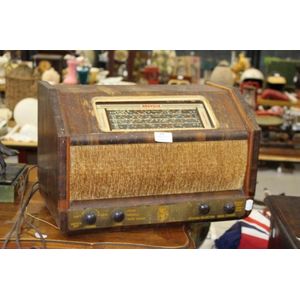Albers' Oak Nesting Tables with Glass Tops
A set of Josef Albers nesting tables, this set of four tables was designed by Bauhaus master Josef Albers. Crafted in Germany from solid oak with lacquered glass tops, these tables are both functional and elegant with meticulous and rich simplicity. Largest height 62 cm, width 60 cm, depth 40 cm
You must be a subscriber, and be logged in to view price and dealer details.
Subscribe Now to view actual auction price for this item
When you subscribe, you have the option of setting the currency in which to display prices to $Au, $US, $NZ or Stg.
This item has been sold, and the description, image and price are for reference purposes only.
- Bauhaus - Bauhaus refers to design concepts that originated at the German art school of the same name that was founded in 1919 by architect Walter Gropius. The school was based on the principles of modernist design, and sought to bridge the gap between art and industry by teaching students how to create functional and aesthetically pleasing designs for mass production.
Bauhaus had a significant impact on modern design and architecture, and is widely considered to be one of the most influential art schools of the 20th century. The school's approach to design emphasized simplicity, functionality, and the use of new materials and technologies. Bauhaus designers sought to create clean, uncluttered designs that were free from unnecessary ornamentation.
Bauhaus had a strong influence on a wide range of artistic fields, including architecture, furniture design, typography, and graphic design. Some of the most iconic examples of Bauhaus design include the Barcelona Chair by Mies van der Rohe, the Bauhaus Building in Dessau by Walter Gropius, and the typography of Herbert Bayer.
Bauhaus was active from 1919 until 1933, when it was forced to close by the Nazi government. However, the school's ideas and principles continue to be influential in design and art to this day. - Oak - Native to Europe and England, oak has been used for joinery, furniture and building since the beginning of the medieval civilisation. It is a pale yellow in colour when freshly cut and darkens with age to a mid brown colour.
Oak as a furniture timber was superceded by walnut in the 17th century, and in the 18th century by mahogany,
Semi-fossilised bog oak is black in colour, and is found in peat bogs where the trees have fallen and been preserved from decay by the bog. It is used for jewellery and small carved trinkets.
Pollard oak is taken from an oak that has been regularly pollarded, that is the upper branches have been removed at the top of the trunk, result that new branches would appear, and over time the top would become ball-like. . When harvested and sawn, the timber displays a continuous surface of knotty circles. The timber was scarce and expensive and was used in more expensive pieces of furniture in the Regency and Victorian periods.
This item has been included into following indexes:
Visually similar items

Two antique French Henri II walnut nightstands, approx 83 cm high 124 cm wide (2)
Sold by
in
for
You can display prices in $Au, $US, $NZ or Stg.

18ct gold huggie style earrings, approx 5.4 grams
Sold by
in
for
You can display prices in $Au, $US, $NZ or Stg.

Two Die cast Promotions models, including 1964 Buick Riviera and 1966 Pontiac Gto
Sold by
in
for
You can display prices in $Au, $US, $NZ or Stg.

Vintage Breville radio, approx 45 cm x 30 cm 26 cm
Sold by
in
for
You can display prices in $Au, $US, $NZ or Stg.
